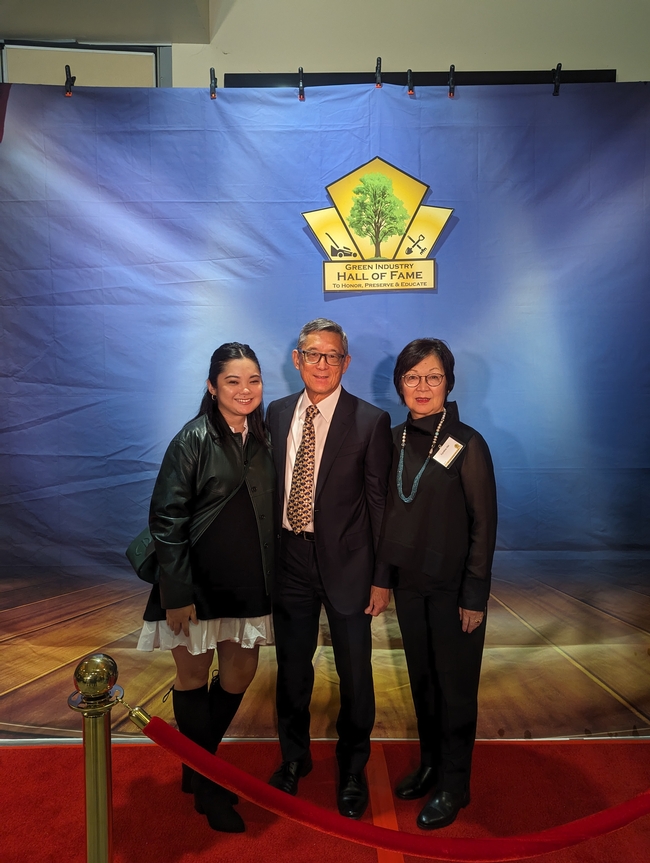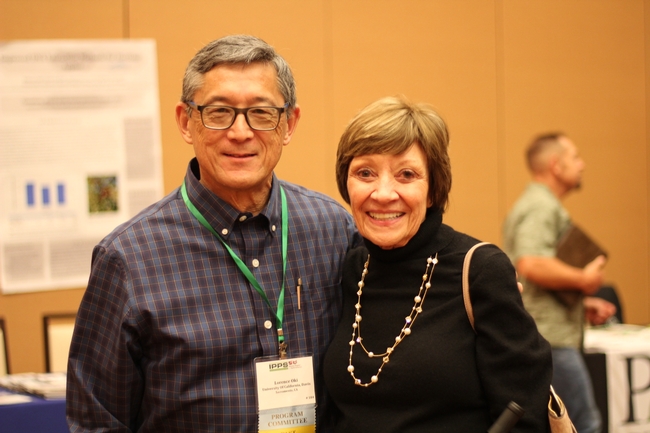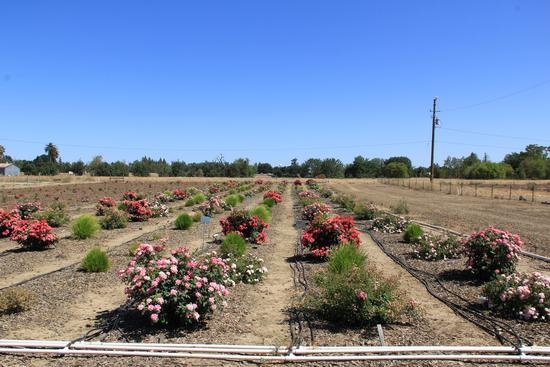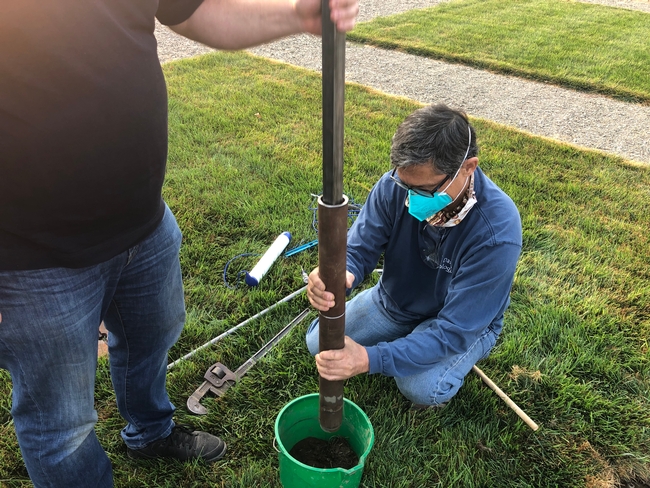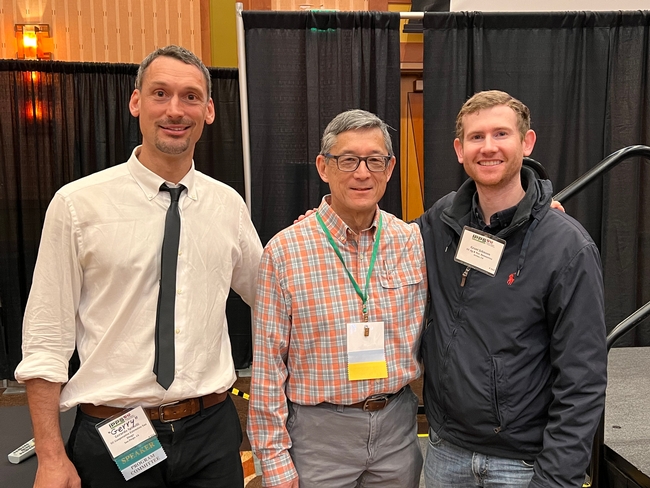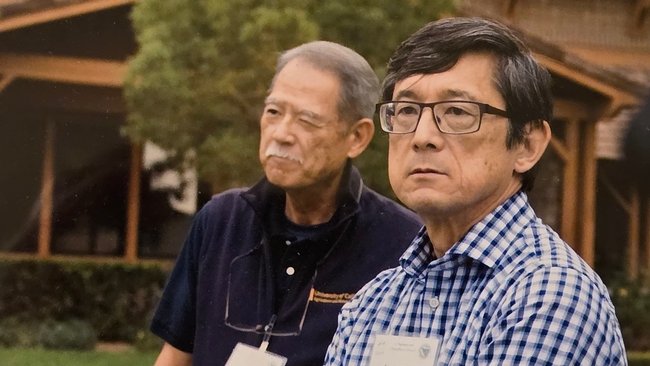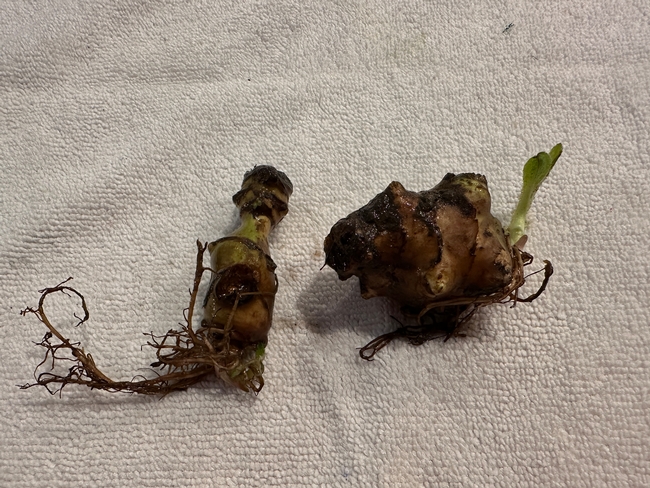UC Blogs
Celebrating Bumble Bees on World Bee Day
It's World Bee Day and there's no better time than to showcase bumble bees, Bombus. The United Nations designated May 20 as World Bee Day to...
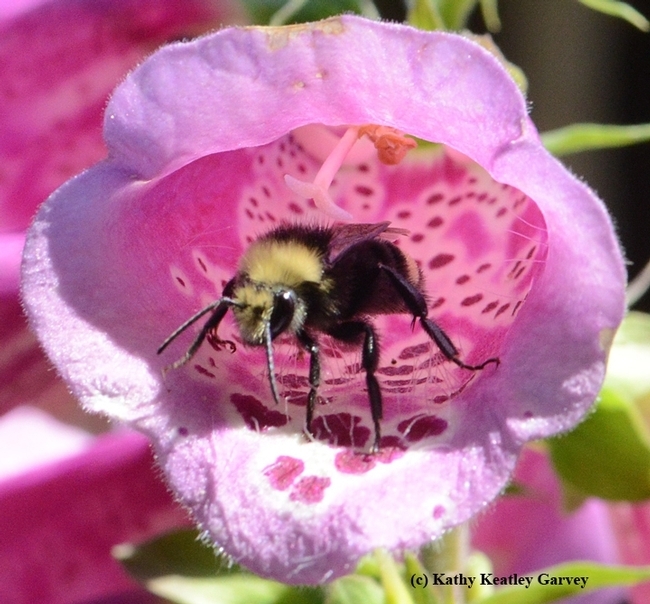
The yellow-faced bumble bee, Bombus vosnesenskii, emerging from a foxglove in Vacaville, Calif. (Photo by Kathy Keatley Garvey)
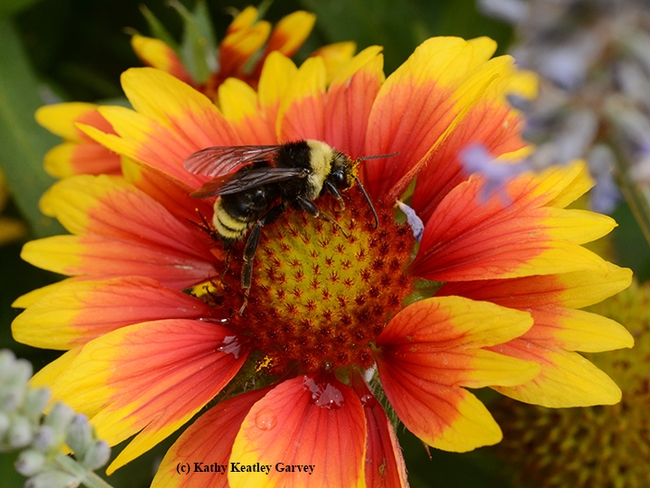
Bombus californicus, "the California bumble bee," foraging on blanket flower, Gaillardia, in Vacaville, Calif. (Photo by Kathy Keatley Garvey)
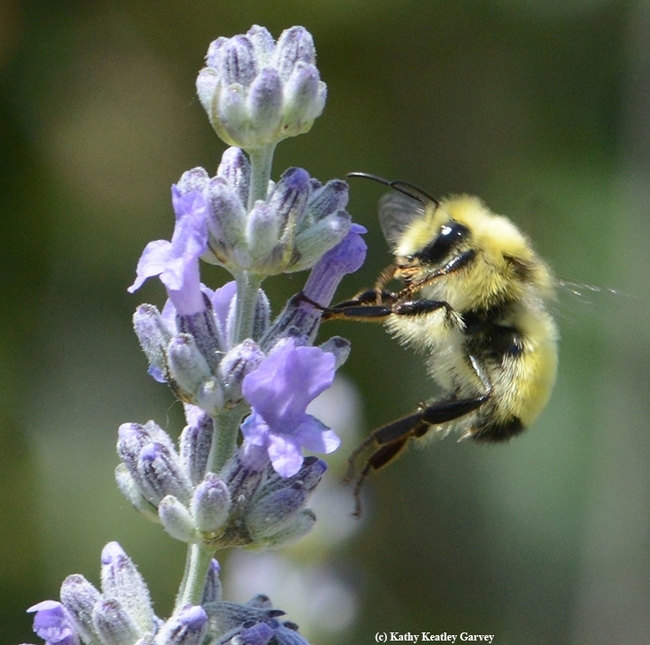
Bombus vandykei, the Van Dyke's bumble bee, foraging on lavender in a Vacaville, Calif. garden. (Photo by Kathy Keatley Garvey)
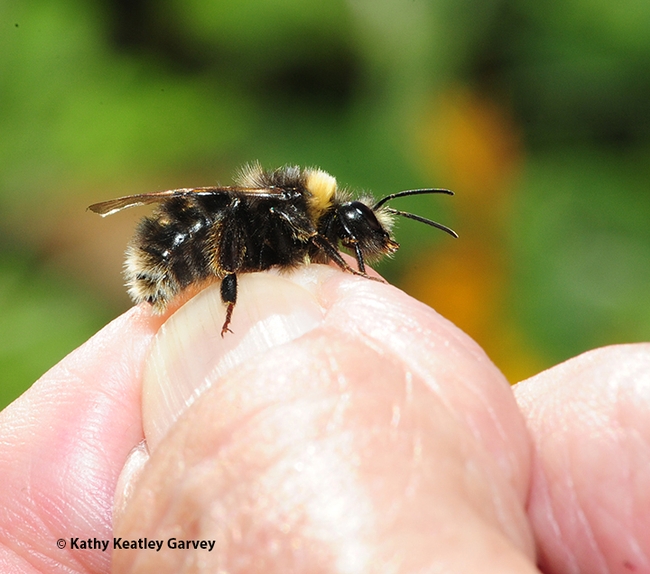
The western bumble bee, Bombus occidentalis, on the hand of the UC Davis distinguished emeritus professor Robbin Thorp (1933-2019). (Photo by Kathy Keatley Garvey)
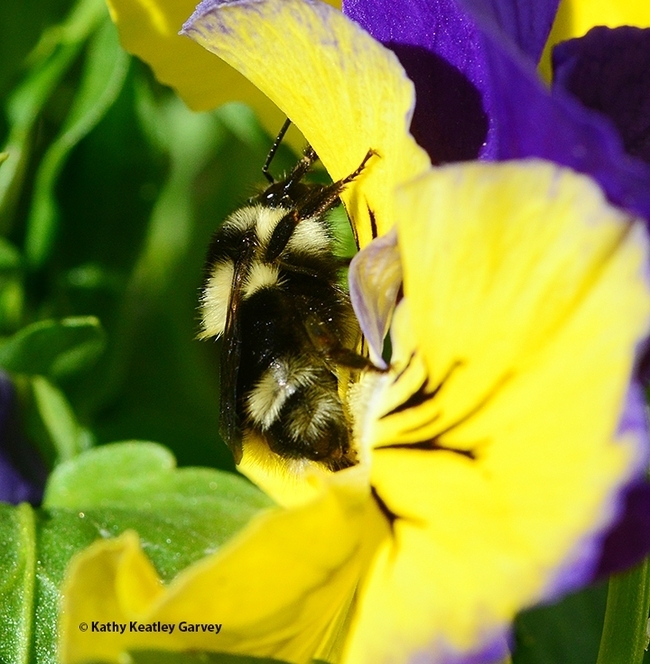
Bombus melanopygus, the black-tailed bumble bee, foraging on a pansy in a Vacaville, Calif. garden. (Photo by Kathy Keatley Garvey)
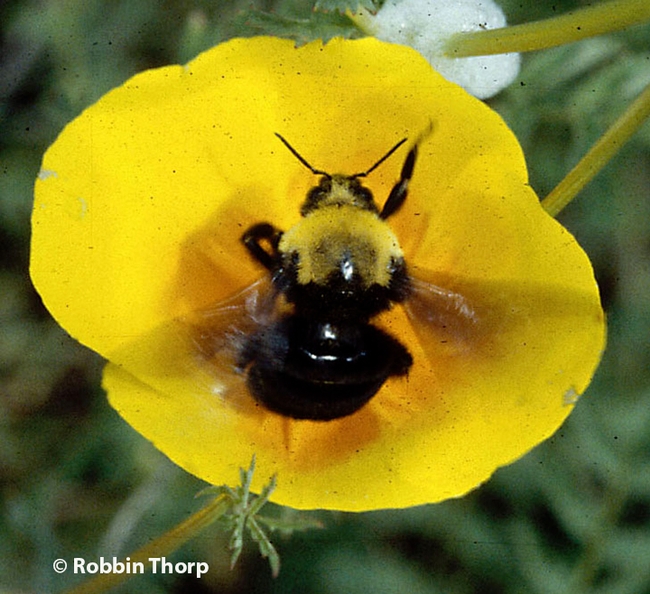
This is Franklin's bumble bee, Bombus franklini, monitored by Robbin Thorp (1933-2019) and now feared extinct. (Photo by Robbin Thorp)
Conserving Your Legacy - Workshop on June 5, 2024
Are you interested in learning more about transitioning your ranching operations to future generations? If so, this workshop is for...
Conserving Your Legacy Speaker List
'Bee' at the Bohart Museum Open House to See Bee Observation Hive and Taste Honey
Want to see a bee observation hive, taste honey, and learn about honey bee health? Those are some of the activities planned when the...
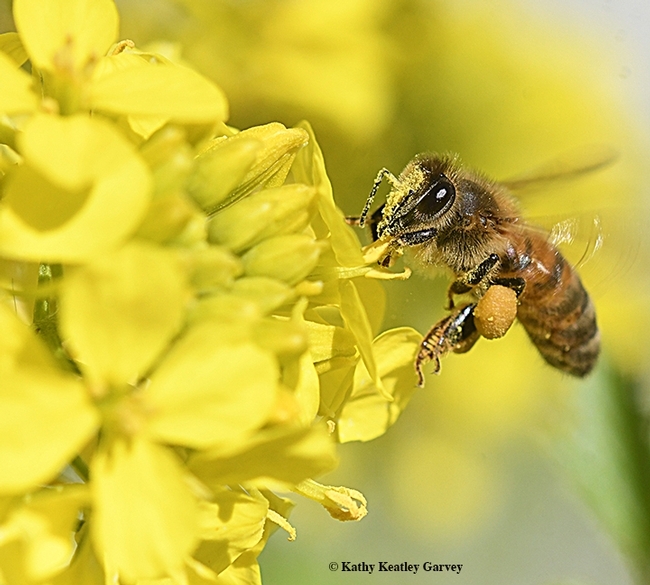
A honey bee, dusted with gold pollen, forages on mustard (Photo by Kathy Keatley Garvey)
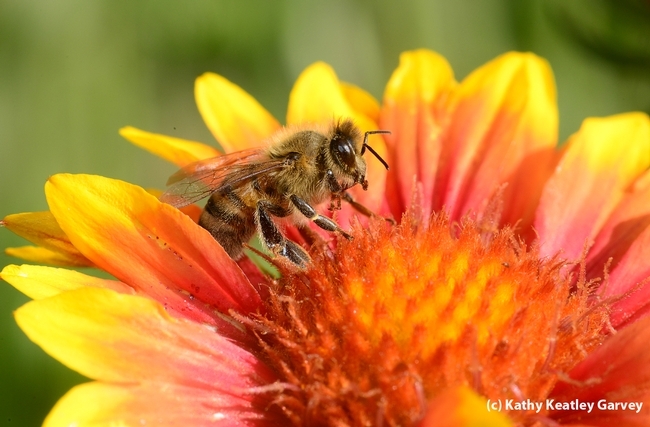
A honey bee foraging on blanketflower, Gaillardia. (Photo by Kathy Keatley Garvey)
Green Hall of Famer Oki retires after 29-year UC career
UCCE specialist's research prevents water pollution, reduces water use
When interviewed to become a University of California Cooperative Extension specialist in environmental horticulture, Lorence “Loren” Oki was asked what kind of research he wanted to conduct.
In response, he showed the hiring committee a photo of a residential gutter. “Water is a big concern, and I found very little research on runoff from homes,” said Oki, explaining that studying residential runoff is what “started his career” with UC Agriculture and Natural Resources back in 2002.
Although he remains active supporting growers and advising industry leaders, Oki retired from UC ANR in July 2023. Before joining ANR, Oki worked as a researcher for UC Davis' Department of Environmental Horticulture studying greenhouse irrigation in 1994, bringing his total time with the University of California to 29 years.
Oki, professor emeritus of Cooperative Extension at UC Davis, led many research projects that advanced the green industry which includes landscapes, nurseries and floriculture.
“Loren is the epitome of a specialist,” said Darren Haver, UC ANR's Research and Extension Center system director, who has worked with Oki for more than 20 years on projects that have significantly improved urban water quality and water conservation efforts across California.
Research influences pesticide management statewide
With a $3 million grant funding a statewide study, Oki and Haver set out to characterize runoff from residential sources over a five-year period. They determined the volume of irrigation runoff from residential land use, as well as the pollutants in the runoff.
Oki and Haver, co-principal investigators, along with researchers from UC Davis and UC Riverside, discovered that the degradation products of the insecticide fipronil – commonly found in runoff water – were more toxic than its parent compound. The study led to an investigation of human pathogens and pathogen indicators in residential runoff, the first of its kind.
Another contribution was the early detection of a new pesticide used for ant control, enabling strategies to be put in place to prevent it from reaching local streams and creeks. Oki and Haver's work also persuaded the California Department of Pesticide Regulation to change pesticide labels to minimize the chances of pesticides moving off target during irrigation and rain events.
These changes included preventing pesticide application before predicted rain and preventing irrigation after applications, keeping pesticides from impervious surfaces, and restricting applications on lawns and landscape beds within two feet of impervious surfaces and others.
Plant trials expand beyond California
Oki was also the principal investigator of the Climate-Ready Landscape Plants project, which may be the largest irrigation trial in the western U.S., and the UC Plant Landscape Irrigation Trials, the California component of that project. The UCPLIT trials originated in 2004 at UC Davis as a research project by Karrie Reid, retired UCCE environmental horticulture advisor for San Joaquin County, while she was pursuing her master's degree. In 2017, the irrigation trials were duplicated at the South Coast Research and Extension Center.
These projects evaluate landscape plants under varying irrigation levels to determine their optimal performance in regions requiring supplemental summer water. Throughout the trial, Oki identified many landscape plants, including rose cultivars, that remain aesthetically pleasing with little water.
Today, the trials have expanded beyond California as the Climate-Ready Landscape Plants Project at Oregon State University, University of Washington, University of Arizona and Utah State University.
Growing up in the nursery industry
In 2017, Oki obtained tenure, allowing him to expand his professional responsibilities to include production horticulture, specifically greenhouses and nurseries, an industry he was extremely familiar with. “I come from a nursery family,” Oki explained. “My grandfather started Oki Nursery in the early 1900s.”
During World War II, Oki's family was incarcerated in the Poston Relocation Center in Arizona and lost their homes and property. When they were released, they returned to the nursery industry to rebuild their lives. “After World War II, my father and uncle got more involved with my grandfather's work,” he said.
The Oki family played an instrumental role in technological development for nurseries in general. Oki Nursery, which was located in Sacramento, worked closely with IBM and was the first to use a computerized system in the industry.
Oki developed computerized scheduling for the bedding plants, poinsettias, chrysanthemums, bulbs and other crops. He developed a method to calculate the cost of any crop grown by the nursery at any point in the crop cycle and computerized greenhouse environmental and irrigation controls. This may not sound impressive now, but that was in the 1980s.
“My father was known for being progressive and he also knew everyone at UC Davis,” said Oki. “He wanted to work with anyone who had an interest in doing something good for nurseries.”
Inducted into Green Industry Hall of Fame
In the 1950s, Oki Nursery partnered with researchers from UC Davis' agricultural engineering program and developed the overhead sprinklers commonly used in nurseries today. Until the 1980s, Oki Nursery was the largest nursery in Northern California. Before it shut down in 1993, Oki worked in the family business as a greenhouse manager when runoff became a growing concern.
“I remember getting served with a notice by the Regional Water Quality Control Board stating that we needed to prevent runoff because it was polluted with nitrate fertilizer, which was common in the nursery industry,” Oki said.
One of those efforts focused on using controlled-release fertilizer instead of applying fertilizer via irrigation as a liquid feed. “What we learned is that if we converted nurseries to controlled-release fertilizer, we could reduce the nitrate runoff,” he said. While a member of the Oki Lab, Bruno Pitton earned his Ph.D. studying nursery hydrology and the fate of nitrogen fertilizers in container crop production adding to the information on runoff and nitrate management. Pitton is now the environmental horticulture advisor for Placer and Nevada counties.
In 2023, Oki was inducted into the Green Industry Hall of Fame, which recognizes individuals with a minimum of 20 years in the landscape, nursery or floriculture industry and who have made significant contributions to the field.
Having grown up in the industry, Oki said that his father taught him to never be afraid to try new things. “If you think you have an idea that might work, do the best you can to make it work. If it doesn't work out, then it doesn't work out. And that's OK,” he said.
Revitalizing space for greater impact
This mentality encouraged Oki whenever tackling new tasks, like rebranding the California Ornamental Research Federation, a space for education and collaboration, as UC Nursery and Floriculture Alliance.
In 2009, Oki and David Fujino, executive director of the California Center for Urban Horticulture, became co-directors of CORF, which catered to the cut flower industry. At that time, Oki and Fujino realized that nurseries generated much greater revenue in the state than cut flowers.
“It was a strategic decision to change CORF to UCNFA, which included floriculture and nurseries in the name,” Fujino said. Combined, nurseries and floriculture have consistently placed in the top five agricultural commodities in the state.
When reflecting on their partnership, Fujino said that working with Oki was a “natural fit.” “I couldn't have asked for a better partner, a better colleague and, ultimately, a better friend to have my back and work side by side,” he added.
Since UCNFA's launch, the two have worked to maintain the group's impact by hosting “Ask your Advisor” webinars to connect advisors to growers, as well as co-hosting large-scale events such as the annual conference for the International Plant Propagators' Society — an organization focused on greenhouse and nursery production education — for the Western Region, which Oki's father helped establish in the 1960s.
Encouraging a return to education
Gerry Spinelli, UC Cooperative Extension production horticulture advisor for San Diego County and member of UCNFA's administrative committee, described those who have learned from Oki as his sons and daughters. “When I meet someone that's learned from Loren or worked with him, that person instantly becomes my friend. That's the kind of effect Loren has on us,” Spinelli said.
Grant Johnson, UC Cooperative Extension urban agricultural technology advisor for Los Angeles and Orange counties, credits Oki for his master's degree in horticulture from UC Davis.
“Loren gave me a lot of direction as far as career choices and research interests. He instilled in me a dedication to life-long learning, just like he continues to do,” said Johnson. Before Oki became his professor, Johnson worked with Oki as a staff research associate at the South Coast Research and Extension Center in Irvine.
Another influential person in Oki's life is John Kabashima, emeritus environmental horticulture advisor for UCCE Orange and Los Angeles counties and fellow Green Hall of Fame inductee. Like Oki, Kabashima grew up in the nursery industry.
Oki, who earned a bachelor's degree in ornamental horticulture from Cal Poly San Luis Obispo and a master's degree in plant science from UC Riverside, decided to pursue a Ph.D. in ecology at UC Davis with Kabashima's encouragement.
While Oki was still working in his family's business, Kabashima said that Oki relied on UC ANR researchers for scientific information and felt like Oki wanted to be one of them. “I told him that he's a good nursery guy, but he's a better scientist,” said Kabashima. “His heart is in science.”
The two began working together as soon as Oki became a graduate student and have been colleagues and friends for nearly 40 years. “My favorite response from Loren whenever people ask him a question is, ‘It depends,'” Kabashima said. “It always leads to people opening up and giving more context. That's what Loren does, he gets you to think.”
Delighted Up About Sunchokes
Sunchoke - Jerusalem Artichoke - Sunroot, Helianthus tuberosus
Edible Tuber
Plant 4-6 inches deep and 12-18 inches apart
Grows 6-10 tall, Needs staking. Use a tee pee or tomato cage
Grow in a Wine Barrel or extra-large pot, because they are a giving plant
1 tuber makes 20 tubers
Regular water until the roots form, then water deeply once a week
6 or more hours of Sun
1” of mulch on top of the soil
Harvest 3½ -5 months later (110-150 days)
Beautiful Yellow Daisy shaped flowers. Cut the flowers before seeds develop! Or you'll have far too many! Perennial that continues to give you tubers for many, many years. Sweet, nutty tasting. A very healthy veggie that can be substituted for potatoes or carrots. Eat them raw. Wash and slice them super thin. Add to salads, dip them in your favorite hummus recipe. Try roasted. Cut them ½ inch thick. Toss them in olive oil, thyme, salt and pepper. Cook in 425? oven for around 20 minutes. Boil them in slightly salty water, until tender. Plunge into a ice water bath. Peel immediately. Slice to desired thickness. Toss with butter, salt and pepper and parsley.
Yum Yum Enjoy!


